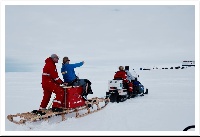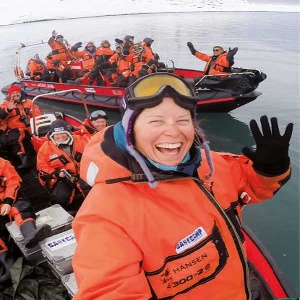Procedures onboard
Information is based on the long-time experience onboard RV Polarstern. There may have been deviations in specific cases but this was not in accordance with the regular behaviour patterns. The procedures in a special case have to be examined and authorised by the chief scientist in accordance with his responsibilities.
The chief scientist is entitled to issue deviations in favour of other regulations. Such deviations must be documented in writing and signed with date and signature (e.g. risk assessments & operating instructions).
In unusual cases of deviation from the good practice the captain will make an entry in the ship's log book.
Regulations of the helicopter operator and ship operator must not be changed.
Some rules of the AWI logistics department can only be changed after agreement with the logistic coordinator for instance regarding devices owned by the locistics department.
Always remember that it has to be possible to rescue the persons not aboard with the second helicopter or from the ship itself within a reasonable timeframe. If this cannot be ensured, the operation is not safe and cannot be conducted.
Usual procedures:
Before the start of the operation on site:
Detailed consultation of the chief scientist with the scientific group about the means of operation, time span, risks and safety measures for the work on the ice.
Captain, chief scientist and meteorologist have to agree upon the the weather situation and the possibility to work on the ice.
A survey party determines ice thickness and ice quality in the vicinity of the ship.
Decision making about the operation by the scientific cruise leadership.
Operation on the ice:
Record your absence in the respective book.
A working group consists of 2 persons at least and has a group leader.
The group leader is responsible for the regular control / assessment of ice thickness and load-bearing capacity.
Each group has to carry a radio device or a Iridium telephone for distances >1 NM. The typhon is the onboard emergency signal for operations close to the ship the. It means: EVERYBODY BACK ONBOARD!
Up to 5 groups are possibleI in the vicinity of the ship (max.1 NM = ca.45min walking) because of the logistical efforts for rescue in the Arctic and Antarctic and due to the armament of the polar bear watch in the Arctic. The number of groups will be reduced if weapons fail or the helicopter is in use.
A hand line may be installed e.g. to the gangway of the ship during longer stays in order to find the ship under difficult conditions such as fog or white out.
Maximum distance by Skidoo is 45 min return time (only 1 skidoo group >1 NM: mandatory are 2 Skidoos with emergency box containing tent, GPS and AIS).
Operations at night are only possible after early agreement and planning because emergency measures may take place time-lagged.
Polar bear watch for each group. The dedicated watchman only ensures safety of the group and must not fulfill other tasks. Group members can take turns so there should be at least 2 persons per group with the respective education. There has to be at least one person on the bridge deck that oversees the operations within <1 NM with regard to polar bears and keeps contact to the groups via radio. According to situation, this may require more manpower.
While working on or close to the open water you need to wear a survival suit probably with warm clothing below. Additionally, the person in questions has to be secured with a line.
There is only survival gear for helicopter operation. Additional survival gear can be lend from the clothing storehouse.
Stations on the ice with RV Polarstern leaving the ice edge: max. 6 persons, survival gear, tents, GPS, AIS, Iridium telephone. The ship may move away up to 95 NM.
After operation:
Field toilets
Pop up tents and field toilets including all necessary equipment are available on board RV Polarstern.
https://www.carplife.uk.com/product-page/bivvy-loo
https://wheretomorrow.co.uk/collections/zelte/products/lumaland-outdoor-pop-up-duschzelt-umkleidezelt-toilettenzelt-stehzelt-camping-trekking-reise-155x155x220-cm-verschiedene-farben?variant=39523400253576

